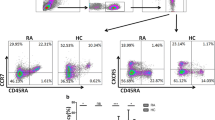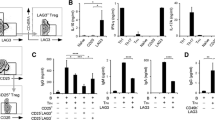Abstract
Regulatory T (Treg) cells hold centre stage in regulating the immune responses in most viral infections. However, their involvement in chikungunya infection is unexplored. In the current study, the frequencies and functionality of peripheral Treg and T effector (Teff) cells were assessed during different phases of chikungunya by flow cytometry and in-vitro cytokine assays. Treg cells were also studied in rheumatoid arthritis (RA) patients, whose symptoms closely mimic chronic chikungunya arthritis patients. Frequency of Treg cells was lower in acute and chronic chikungunya arthritis patients than in recovered individuals and controls, and comparable among recovered individuals and controls. Treg/Teff ratio was lower in acute than in chronic chikungunya arthritis patients, recovered individuals and controls. Higher secretion of CHIKV specific IL-10 was observed in recovered individuals than in acute, chronic chikungunya arthritis patients and controls. Frequencies of Treg and Teff cells were higher and Treg/Teff ratio was lower in RA patients than in chronic chikungunya arthritis patients. The results indicate that reduction of Treg cells was associated with ongoing CHIKV infection and normalization of Treg cells with resolution of disease. Contrasting phenotypic data in RA and chronic chikungunya arthritis suggest an altogether different mechanism of Treg-mediated pathology in both arthritis conditions. Overall, our preliminary study, suggesting an association of peripheral Treg cells and IL-10 with recovery from chikungunya, may provide insight into chikungunya disease prognosis and warrants further study.





Similar content being viewed by others
References
Powers AM (2015) Risks to the Americas associated with the continued expansion of chikungunya virus. J Gen Virol 96:1–5
Thiberville SD, Moyen N, Dupuis-Maguiraga L, Nougairede A, Gould EA, Roques P, de Lamballerie X (2013) Chikungunya fever: epidemiology, clinical syndrome, pathogenesis and therapy. Antivir Res 99:345–370
Long KM, Heise MT (2015) Protective and pathogenic responses to chikungunya virus infection. Curr Trop Med Rep 2:13–21
Hoarau JJ, Jaffar Bandjee MC, Krejbich Trotot P, Das T, Li-Pat-Yuen G, Dassa B et al (2010) Persistent chronic inflammation and infection by Chikungunya arthritogenic alphavirus in spite of a robust host immune response. J Immunol 184:5914–5927
Teo TH, Lum FM, Claser C, Lulla V, Lulla A, Merits A, Renia L, Ng LF (2013) A pathogenic role for CD4+ T cells during Chikungunya virus infection in mice. J Immunol 190:259–269
Hawman DW, Stoermer KA, Montgomery SA, Pal P, Oko L, Diamond MS, Morrison TE (2013) Chronic joint disease caused by persistent Chikungunya virus infection is controlled by the adaptive immune response. J Virol 87:13878–13888
Hoarau JJ, Gay F, Pelle O, Samri A, Jaffar-Bandjee MC, Gasque P, Autran B (2013) Identical strength of the T cell responses against E2, nsP1 and capsid CHIKV proteins in recovered and chronic patients after the epidemics of 2005–2006 in La Reunion Island. PLoS One 8:e84695
Wauquier N, Becquart P, Nkoghe D, Padilla C, Ndjoyi-Mbiguino A, Leroy EM (2011) The acute phase of Chikungunya virus infection in humans is associated with strong innate immunity and T CD8 cell activation. J Infect Dis 204:115–123
Hori S, Nomura T, Sakaguchi S (2003) Control of regulatory T cell development by the transcription factor Foxp3. Science 299:1057–1061
Liu W, Putnam AL, Xu-Yu Z, Szot GL, Lee MR, Zhu S, Gottlieb PA, Kapranov P, Gingeras TR, Fazekas de St Groth B, Clayberger C, Soper DM, Ziegler SF, Bluestone JA (2006) CD127 expression inversely correlates with FoxP3 and suppressive function of human CD4+ T reg cells. J Exp Med 203:1701–1711
Miyara M, Sakaguchi S (2007) Natural regulatory T cells: mechanisms of suppression. Trends Mol Med 13:108–116
Tillu H, Tripathy AS, Reshmi PV, Cecilia D (2015) Altered profile of regulatory T cells and associated cytokines in mild and moderate dengue. Eur J Clin Microbiol Infect Dis 35:453–461
Rathod SB, Tripathy AS (2016) TGF-beta1 and contact mediated suppression by CD4+CD25+CD127- T regulatory cells of patients with self-limiting hepatitis E. Hum Immunol 77:1254–1263
Lee WW, Teo TH, Her Z, Lum FM, Kam YW, Haase D, Renia L, Rotzschke O, Ng LF (2015) Expanding regulatory T cells alleviates chikungunya virus-induced pathology in mice. J Virol 89(15):7893–7904. https://doi.org/10.1128/JVI.00998-15
Thanapati S, Ganu M, Giri P, Kulkarni S, Sharma M, Babar P, Ganu A, Tripathy AS (2017) Impaired NK cell functionality and increased TNF-alpha production as biomarkers of chronic chikungunya arthritis and rheumatoid arthritis. Hum Immunol 78(4):370–374. https://doi.org/10.1016/j.humimm.2017.02.006
Aletaha D, Neogi T, Silman AJ, Funovits J et al (2010) Rheumatoid arthritis classification criteria: an American College of Rheumatology/European League Against Rheumatism collaborative initiative. Arthritis Rheum 62:2569–2581
Patil DR, Hundekar SL, Arankalle VA (2012) Expression profile of immune response genes during acute myopathy induced by chikungunya virus in a mouse model. Microbes Infect 14:457–469
Gadkari DA, Shaikh BH (1984) IgM antibody capture ELISA in the diagnosis of Japanese encephalitis, West Nile & dengue virus infections. Indian J Med Res 80:613–619
Kumar M, Sudeep AB, Arankalle VA (2012) Evaluation of recombinant E2 protein-based and whole-virus inactivated candidate vaccines against chikungunya virus. Vaccine 30:6142–6149
Thanapati S, Das R, Tripathy AS (2015) Phenotypic and functional analyses of NK and NKT-like populations during the early stages of chikungunya infection. Front Microbiol 6:895
Rathod SB, Das R, Thanapati S, Arankalle VA, Tripathy AS (2014) Suppressive activity and altered conventional phenotype markers/mediators of regulatory T cells in patients with self-limiting hepatitis E. J Viral Hepat 21:141–151
Rathod SB, Tripathy AS (2014) Hepatitis E rORF2p stimulated and unstimulated peripheral expression profiling in patients with self-limiting hepatitis E infection. J Immunol Res 2014:565284
Komatsu N, Takayanagi H (2015) Regulatory T cells in arthritis. Prog Mol Biol Transl Sci 136:207–215
Hunt L, Hensor EM, Nam J, Burska AN, Parmar R, Emery P, Ponchel F (2015) T cell subsets: an immunological biomarker to predict progression to clinical arthritis in ACPA-positive individuals. Ann Rheum Dis 75:1884–1889
Ng LF, Chow A, Sun YJ, Kwek DJ, Lim PL, Dimatatac F, Ng LC, Ooi EE, Choo KH, Her Z, Kourilsky P, Leo YS (2009) IL-1beta, IL-6, and RANTES as biomarkers of Chikungunya severity. PLoS One 4:e4261
Kelvin AA, Banner D, Silvi G, Moro ML, Spataro N, Gaibani P, Cavrini F, Pierro A, Rossini G, Cameron MJ, Bermejo-Martin JF, Paquette SG, Xu L, Danesh A, Farooqui A, Borghetto I, Kelvin DJ, Sambri V, Rubino S (2011) Inflammatory cytokine expression is associated with chikungunya virus resolution and symptom severity. PLoS Negl Trop Dis 5:e1279
Venugopalan A, Ghorpade RP, Chopra A (2013) Cytokines in acute chikungunya. PLoS One 9:e111305
Uhrlaub JL, Pulko V, DeFilippis VR, Broeckel R, Streblow DN, Coleman GD, Park BS, Lindo JF, Vickers I, Anzinger JJ, Nikolich-Zugich J (2014) Dysregulated TGF-beta production underlies the age-related vulnerability to Chikungunya virus. PLoS Pathog 12:e1005891
Chow A, Her Z, Ong EK, Chen JM, Dimatatac F, Kwek DJ, Barkham T, Yang H, Renia L, Leo YS, Ng LF (2011) Persistent arthralgia induced by Chikungunya virus infection is associated with interleukin-6 and granulocyte macrophage colony-stimulating factor. J Infect Dis 203:149–157
Borgherini G, Poubeau P, Staikowsky F, Lory M, Le Moullec N, Becquart JP, Wengling C, Michault A, Paganin F (2007) Outbreak of chikungunya on Reunion Island: early clinical and laboratory features in 157 adult patients. Clin Infect Dis 44:1401–1407
Luhn K, Simmons CP, Moran E, Dung NT, Chau TN, Quyen NT, Thao le TT, Van Ngoc T, Dung NM, Wills B, Farrar J, McMichael AJ, Dong T, Rowland-Jones S (2007) Increased frequencies of CD4+ CD25(high) regulatory T cells in acute dengue infection. J Exp Med 204:979–985
Miner JJ, Aw Yeang HX, Fox JM, Taffner S, Malkova ON, Oh ST, Kim AH, Diamond MS, Lenschow DJ, Yokoyama WM (2015) Chikungunya viral arthritis in the United States: a mimic of seronegative rheumatoid arthritis. Arthritis Rheumatol 67:1214–1220
Monte K, Wilson C, Shih FF (2008) Increased number and function of FoxP3 regulatory T cells during experimental arthritis. Arthritis Rheum 58:3730–3741
van Amelsfort JM, Jacobs KM, Bijlsma JW, Lafeber FP, Taams LS (2004) CD4(+)CD25(+) regulatory T cells in rheumatoid arthritis: differences in the presence, phenotype, and function between peripheral blood and synovial fluid. Arthritis Rheum 50:2775–2785
Acknowledgements
We thank the Director, National Institute of Virology, Pune, India, for all the encouragement. Special thanks are due to Mr. Prasad Babar, Mr. Vasant Walkoli and Mr. Shirish Vaidya for technical help. The authors would like to thank the Indian Council of Medical Research, New Delhi, India for providing the funds for the project.
Author information
Authors and Affiliations
Corresponding author
Ethics declarations
Conflict of interest
The authors declare that there is no conflict of interests regarding the publication of this paper.
Ethical approval
All procedures performed in this study were in accordance with the ethical standards of the institutional and/or national research committee and with the 1964 Helsinki Declaration and its later amendments or comparable ethical standards.
Rights and permissions
About this article
Cite this article
Kulkarni, S.P., Ganu, M., Jayawant, P. et al. Regulatory T cells and IL-10 as modulators of chikungunya disease outcome: a preliminary study. Eur J Clin Microbiol Infect Dis 36, 2475–2481 (2017). https://doi.org/10.1007/s10096-017-3087-4
Received:
Accepted:
Published:
Issue Date:
DOI: https://doi.org/10.1007/s10096-017-3087-4




